 W
WArgos Hill Mill is a grade II* listed post mill at Argos Hill, Mayfield, East Sussex, England
 W
WAshcombe Mill was a post mill near the village of Kingston near Lewes, East Sussex, England. It was built in 1828 on Kingston ridge to the east of the village, probably by the millwright Samuel Medhurst of Lewes, who was responsible for building several other windmills in the area. That original mill was destroyed during a gale in 1916.
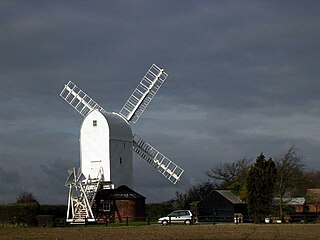 W
WAythorpe Roding Windmill is a Grade II* listed Post mill at Aythorpe Roding, Essex, England which has been restored to working order.
 W
WBocking Windmill or Bocking Churchstreet Windmill is a grade I listed Post mill at Bocking, Essex, England which has been restored.
 W
WBragg's Mill, William Bragg's Mill, Bartlow Hamlet Mill or Stevington End Mill is a grade II listed post mill at Ashdon, Essex, England which has been restored.
 W
WBrill is a village and civil parish in west Buckinghamshire, England, close to the border with Oxfordshire. It is about 4 miles (6 km) north-west of Long Crendon and 7 miles (11 km) south-east of Bicester. At the 2011 Census, the population of the civil parish was 1,141. Brill has a royal charter to hold a weekly market, but has not done so for many years.
 W
WChillenden windmill is a grade II* listed open-trestle post mill north of Chillenden, Kent, England. It is the last post mill built in Kent.
 W
WClavering Windmills are a pair of Grade II listed Tower mills at Clavering, Essex, England. They have both been converted to residential use. They are named North Mill and South Mill. A third mill existed in Clavering until the mid-nineteenth century, known as Clavering Mill.
 W
WClayrack Drainage Windmill is located at How Hill in the English county of Norfolk. It is on the east bank of the River Ant close to How Hill, a large Edwardian building which houses the Norfolk Broads Study Centre. The Drainage mill is 1¾ miles west of the village of Ludham.
 W
WCromer Windmill, restored in four stages between 1967 and 1998, is a Grade II* listed post mill at Cromer, Ardeley, Hertfordshire, England.
 W
WDrinkstone Windmills are a pair of windmills at Drinkstone, Suffolk, England. They consist a post mill and a smock mill. The post mill is Grade I listed and the smock mill is Grade II* listed. The mills were known as Clover's Mills as they were always worked by the Clover family.
 W
WDrinkstone Windmills are a pair of windmills at Drinkstone, Suffolk, England. They consist a post mill and a smock mill. The post mill is Grade I listed and the smock mill is Grade II* listed. The mills were known as Clover's Mills as they were always worked by the Clover family.
 W
WDuck End Mill, Letch's Mill or Finchingfield Post Mill is a grade II listed Post mill at Finchingfield, Essex, England which has been restored.
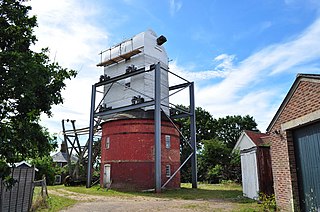 W
WFriston Windmill is a Grade II* listed post mill at Friston, Suffolk, England which has been conserved.
 W
WFryerning Mill is a grade II* listed post mill at Mill Green, Fryerning, Essex, which has been restored.
 W
WGarboldisham Mill is a Grade II* listed post mill at Garboldisham, Norfolk, that has been restored.
 W
WDurrington or High Salvington Windmill is a Grade II listed post mill in High Salvington, Sussex that has been restored and is in full working order. The mill stands 320 feet (98 m) above sea level and is able to take advantage of incoming sea winds.
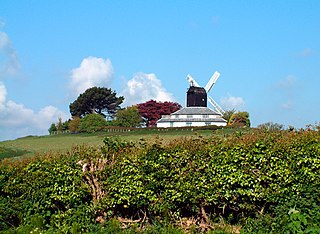 W
WHogg Hill Mill is a post mill at Icklesham in East Sussex, England.
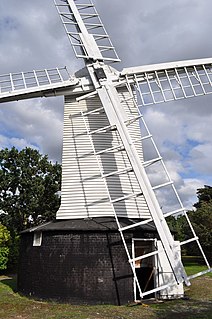 W
WHolton Windmill is a Grade II listed post mill at Holton, Suffolk, England which has been preserved as a landmark.
 W
WKeston Windmill is a grade I listed Post mill in Keston, formerly in Kent and now in the London Borough of Bromley. The mill was built in 1716 and is conserved with its machinery intact but not in working order.
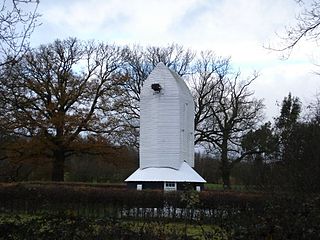 W
WLowfield Heath Windmill is a grade II listed post mill at Charlwood, Surrey, England which has been restored to working order.
 W
WMountnessing Windmill is a grade II* listed post mill at Mountnessing, Essex, England. Built in 1807, it was most recently restored to working order in 1983.
 W
WNew Mill is a Grade II* listed post mill at Cross in Hand near Heathfield, East Sussex, England. It was the last windmill working commercially by wind in Sussex, ceasing work by wind in 1969 when a stock broke.
 W
WNew Mill is a grade II listed post mill at Tadworth, Surrey, England which is on the Buildings at Risk Register.
 W
WNutley Windmill is a grade II* listed open trestle post mill at Nutley, East Sussex, England which has been restored to working order.
 W
WOldland Windmill is an 18th-century post mill situated in the village of Keymer, West Sussex, England.
 W
WOutwood Windmill is a Grade I listed post mill in Outwood, Surrey. Built in 1665 by Thomas Budgen, a miller from Nutfield in Surrey, it is Britain's oldest working windmill.
 W
WPalmer's Drainage Windmill is located to the north of Upton Dyke close to the village of Upton in the English county of Norfolk. Upton Dyke runs westerly from the River Bure in the civil parish of Upton with Fishley . The Drainage mill can be found to the east of the village of Upton.
 W
WPitstone Windmill is a Grade II* listed windmill in England which is thought to date from the early 17th century. It stands in the north-east corner of a large field near the parish boundary of Ivinghoe and Pitstone in Buckinghamshire, and belongs today to the National Trust.
 W
WRamsey Windmill is a grade II* listed post mill at Ramsey, Essex, England which has been restored.
 W
WReigate Heath Windmill is a grade II* listed post mill at Reigate Heath, Surrey, England which has been restored and is used as a chapel. It is thought to be the only windmill in the world which is a consecrated church.
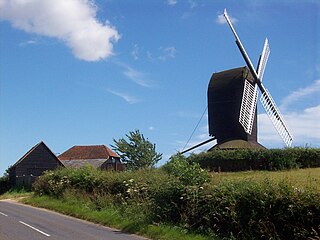 W
WRolvenden Windmill is a grade II* listed Post mill on the B2086 road west of Rolvenden in southeast England. It is maintained as a memorial to a local resident killed in a road accident in 1955.
 W
WSaxtead Green Post Windmill is a Grade II* listed post mill at Saxtead Green, Woodbridge, Suffolk, England which is also an Ancient Monument and has been restored.
 W
WSt Leonard's mill was a post mill at Winchelsea, East Sussex, England which was blown down in the Great Storm of 1987.
 W
WStarston Wind Pump is a hollow post mill for pumping water, situated west of the village of Starston in Norfolk, England. The Pump is 330 yards away from the parish church of Saint Margaret in Mill Field. The windpump is a Grade II listed building and a scheduled ancient monument. After some years on the Heritage at Risk Register because of its poor condition, it was restored in 2010.
 W
WStocks Mill is a Grade II* listed post mill in Wittersham on the Isle of Oxney, in Kent, England which has been preserved.
 W
WThorpeness Windmill is a Grade II listed post mill at Thorpeness, Suffolk, England which was built in 1803 at Aldringham and moved to Thorpeness in 1923. Originally built as a corn mill, it was converted to a water pumping mill when it was moved to Thorpeness. It pumped water to the House in the Clouds.
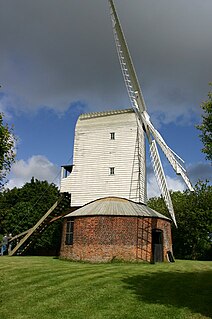 W
WThrigby Post Windmill is located in the civil parish of Mautby in the English county of Norfolk. The mill is on the south side of Mill Lane 1,125 yards (1.029 km) east of the village of Thrigby. The post mill is north of The River Bure, Breydon Water and the Halvergate Marshes.
 W
WUpthorpe Mill is a Grade II* listed post mill and Scheduled Ancient Monument at Stanton, Suffolk, England, which has been restored to working order.
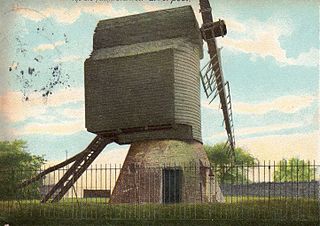 W
WFirst recorded in 1452, the Wavertree windmill was one of only four 'King's Mills' in Liverpool, England. Located behind present-day 35 and 37 Beverly Road (L15), for nearly 200 years it was the property of the crown, until in 1639 Charles I granted it to Lord Strange, a son of Lord Derby. By the 18th century the ownership of the mill had passed to Bamber Gascoyne, tenant of Childwall Hall. It then passed to the Marquess of Salisbury and finally was leased by Colonel James Bourne of Heathfield. The mill was wrecked in a storm in 1898. It was demolished in 1916.
 W
WFramsden Windmill is a Grade II* listed post mill at Framsden, Suffolk, England which is preserved. The mill was known as Webster's Mill when it was a working mill.
 W
WWest Kingsdown Windmill is a Grade II listed smock mill in West Kingsdown, Kent, England, that was built in the early nineteenth century at Farningham and moved to West Kingsdown in 1880. It is the survivor of a pair of windmills.
 W
WThe Weald and Downland Living Museum is an open-air museum in Singleton, West Sussex. The museum is a registered charity.
 W
WWimbledon Windmill is a Grade II* listed windmill situated on Wimbledon Common in the London Borough of Merton, in the west of South London, and is preserved as a museum.
 W
WWindmill Hill Mill is a grade II* listed post mill at Herstmonceux, Sussex, England which has been restored and now operates as a working mill. The mill is open to the public on most Sundays from Easter until October.
 W
WWrawby Postmill is a windmill at Wrawby near Brigg, in North Lincolnshire, England.